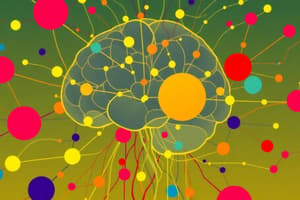Podcast
Questions and Answers
What is a characteristic of knowledge in the real world?
What is a characteristic of knowledge in the real world?
- It is always well-organized and well-formatted.
- Its volume is minimal and easily manageable.
- It is limited to structured datasets only.
- It consists largely of unstructured and heterogeneous data. (correct)
Which of the following best describes the nature of real-world knowledge regarding volume?
Which of the following best describes the nature of real-world knowledge regarding volume?
- It is consistently small and manageable.
- It is primarily qualitative in its representation.
- It is completely uniform in size.
- It has a huge volume, akin to big data. (correct)
How is real-world knowledge typically formatted?
How is real-world knowledge typically formatted?
- It is always in a structured format.
- It is usually in a well-organized manner.
- It is exclusively comprised of quantitative data.
- It is often unorganized and poorly structured. (correct)
What aspect of knowledge can be described as 'unimaginable' in real-world contexts?
What aspect of knowledge can be described as 'unimaginable' in real-world contexts?
What type of data does the term 'unstructured data' refer to in the context of knowledge?
What type of data does the term 'unstructured data' refer to in the context of knowledge?
What is the color associated with a bluebird?
What is the color associated with a bluebird?
Which of the following correctly describes the size of a bluebird?
Which of the following correctly describes the size of a bluebird?
Which property is attributed to birds in general?
Which property is attributed to birds in general?
What type of animal classification does a bluebird belong to?
What type of animal classification does a bluebird belong to?
What covering is commonly found on birds, including the bluebird?
What covering is commonly found on birds, including the bluebird?
What is meant by the representational adequacy property?
What is meant by the representational adequacy property?
Which aspect is essential for effectiveness in data representation?
Which aspect is essential for effectiveness in data representation?
What must an effective representation also accommodate?
What must an effective representation also accommodate?
Which of the following is NOT a requirement for representational adequacy?
Which of the following is NOT a requirement for representational adequacy?
How does effective data representation relate to knowledge?
How does effective data representation relate to knowledge?
What do the nodes in a semantic net represent?
What do the nodes in a semantic net represent?
What geometric shapes can nodes in a semantic net take?
What geometric shapes can nodes in a semantic net take?
How do links in a semantic net function?
How do links in a semantic net function?
What do the arrows in a semantic net signify?
What do the arrows in a semantic net signify?
In a semantic net, what is the primary function of links?
In a semantic net, what is the primary function of links?
What does the term 'structural' refer to in the context of node links?
What does the term 'structural' refer to in the context of node links?
In semantic terms, what do the links between nodes represent?
In semantic terms, what do the links between nodes represent?
Which of the following is an example of procedural operations in node-link structures?
Which of the following is an example of procedural operations in node-link structures?
What can be listed from a link according to the procedural definition?
What can be listed from a link according to the procedural definition?
How are out-links related to a node in procedural terms?
How are out-links related to a node in procedural terms?
Flashcards are hidden until you start studying
Study Notes
AI Techniques using Semantic Networks
- Real-world knowledge is vast (Big Data) and disorganized (unstructured data).
- Semantic Networks are a technique used in Artificial Intelligence to represent knowledge.
- Semantic Networks use specialized nodes and links to represent relationships between objects.
- Nodes: Represent objects, and are shaped as circles, ellipses, or rectangles.
- Links: Represent relations between objects, represented as arrows pointing from one node to another.
- Structural: Each link connects a tail node to a head node.
- Semantic: Nodes and links represent specific entities within a specific application.
- Procedural: Enables actions like constructing a node, creating a link, listing out-links from a node, listing the tail node from a link, and listing the label from a link.
- Representational Adequacy: Semantic Networks must accurately and completely represent necessary data.
- Effectiveness: Semantic Networks must allow for inference of new knowledge from existing knowledge and be computationally-friendly.
Studying That Suits You
Use AI to generate personalized quizzes and flashcards to suit your learning preferences.




